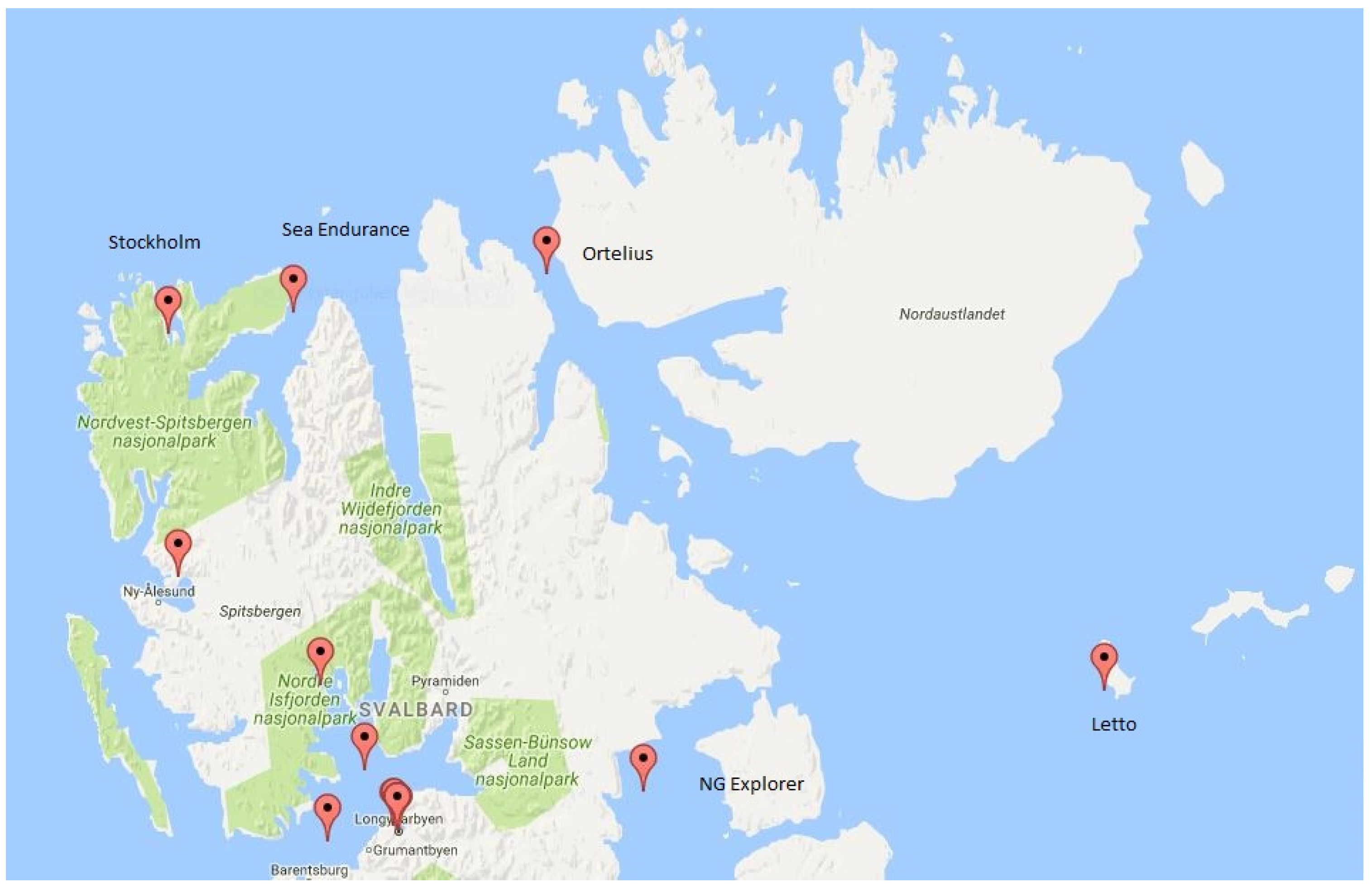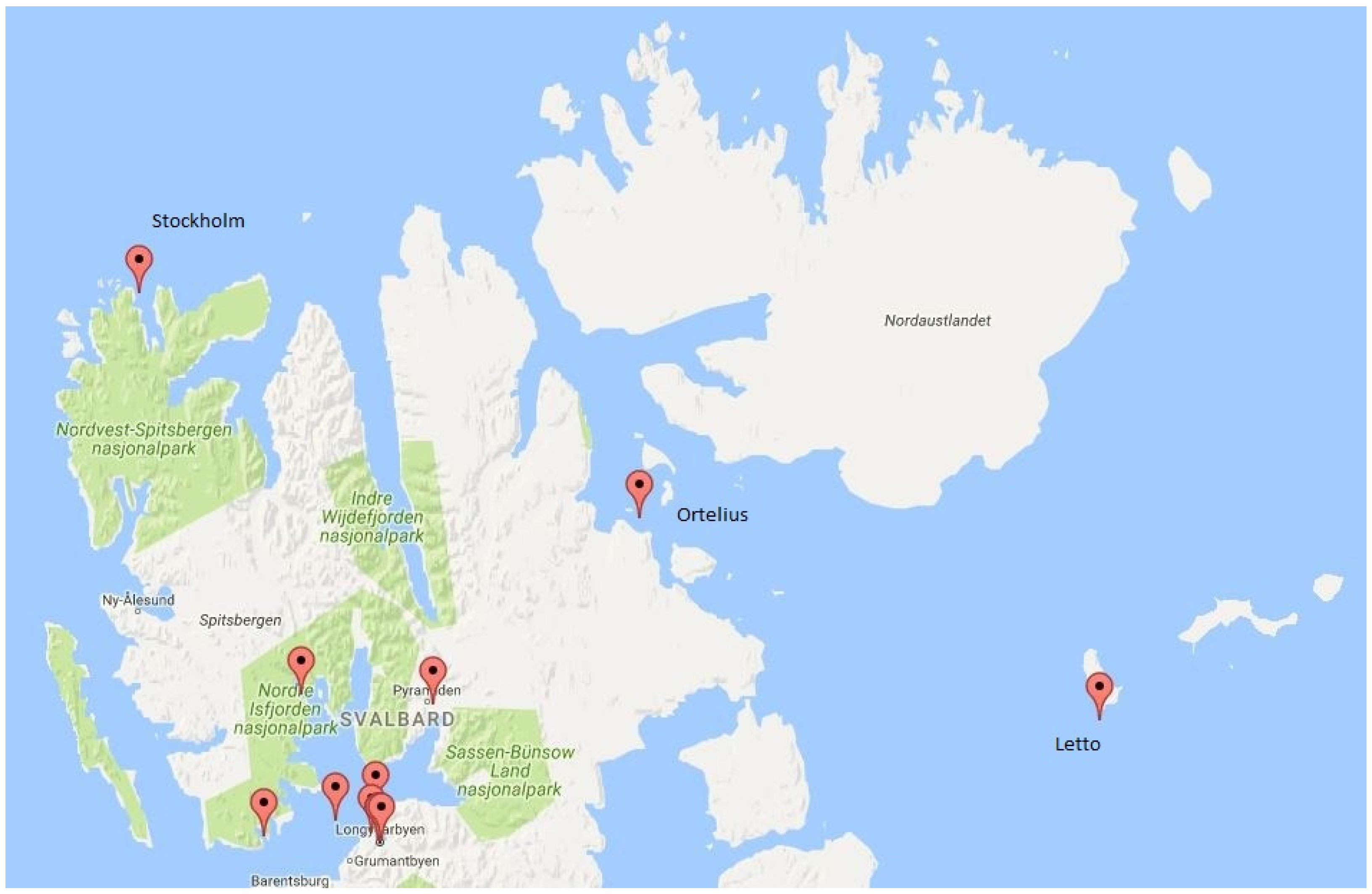The Ortelius Incident in the Hinlopen Strait—A Case Study on How Satellite-Based AIS Can Support Search and Rescue Operations in Remote Waters
Abstract
:1. Introduction
2. Materials and Methods
The Technology
3. Results
4. Discussion
5. Conclusions
Acknowledgments
Conflicts of Interest
References
- Ylvisåker, L.N. Slept til byen. 2016. Available online: http://svalbardposten.no/nyheter/slept-til-byen/19.7240 (accessed on 1 July 2017).
- The Governor of Svalbard. Ekspedisjonsskip Slept til Longyearbyen av Polarsyssel (Press Release). Available online: http://www.sysselmannen.no/Nyheter/Ekspedisjonsskip-slept-til-Longyearbyen-av-Polarsyssel-/ (accessed on 1 July 2017).
- Engås, C. Passasjerskip har motorhavari i Hinlopenstretet. Svalbardposten (Internet). 2016. Available online: http://svalbardposten.no/nyheter/passasjerskip-har-motorhavari-i-hinlopenstretet/19.7238 (accessed on 1 July 2017).
- International Maritime Organization. AIS transponders. Available online: http://www.imo.org/en/OurWork/Safety/Navigation/Pages/AIS.aspx (accessed on 1 July 2017).
- Arctic Council. Agreement on cooperation on aeronautical and maritime search and rescue in the Arctic. In Proceedings of the Ministerial Meeting, Nuuk, Greenland, 12 May 2011. [Google Scholar]
- Aase, J.G.; Jabour, J. Can monitoring maritime activities in the European High Arctic by satellite-based Automatic Identification System enhance polar search and rescue? Polar J. 2015, 5, 1–17. [Google Scholar] [CrossRef]
- Norwegian Space Centre. Norway’s Satellites. Available online: http://www.romsenter.no/eng/Norway-in-Space/Norway-s-Satellites (accessed on 24 April 2017).
- AISSat-1 Satellite Details. Available online: http://www.n2yo.com/satellite/?s=36797 (accessed on 24 April 2017).
- ITU. Technical Characteristics for an Automatic Identification System Using Time Division Multiple Access in the VHF Maritime Mobile Frequency Band; ITU: Geneva, Switzerland, 2014. [Google Scholar]
- Clazzer, A.M.; Berioli, M.; Lazaro Blasco, F. On the Characterization of AIS Traffic at the Satellite 2014:(1 p.). Available online: https://login.ezproxy.utas.edu.au/login?url=http://search.ebscohost.com/login.aspx?direct=true&db=edseee&AN=edseee.6964425&site=eds-live (accessed on 2 July 2017).
- Shelmerdine, R.L. Teasing out the detail: How our understanding of marine AIS data can better inform industries, developments, and planning. Mar Policy 2015, 54, 17–25. [Google Scholar] [CrossRef]
- Security NC-USDoH. Types of AIS Updated 10/21/2015. Available online: http://www.navcen.uscg.gov/?pageName=typesAIS (accessed on 1 July 2017).
- Security NC-USDoH. Class A AIS Position Reports (Messages 1, 2 and 3) Updated 09/12/2014. Available online: http://www.navcen.uscg.gov/?pageName=AISMessagesA (accessed on 1 July 2017).
- International Maritime Organization. International Code for Ships Operating in Polar Waters (Polar Code); International Maritime Organization: London, UK, 2014. [Google Scholar]
- English, J.; Hewitt, R.; Power, D.; Tunaley, J. (Eds.) ICE-SAIS—Space-based AIS and SAR for improved Ship and Iceberg Monitoring. In Proceedings of the 2013 IEEE Radar Conference (RadarCon13), Ottawa, ON, Canada, 29 April–3 May 2013. [Google Scholar]
- SINTEF. Analysis of Maritime Safety Management in the High North (MARSAFE); SINTEF: Trondheim, Norway, 2010. [Google Scholar]




| Ground Time (J2000-Format) | Ground Time (UTC) | Number of Class A Transponders | Number of Class B Transponders |
|---|---|---|---|
| 518210407 | 07:19:03 | 17 | 0 |
| 518216384 | 08:58:40 | 19 | 0 |
| 518222190 | 10:35:26 | 17 | 0 |
| 518227993 | 12:12:11 | 15 | 0 |
| 518233702 | 13:47:20 | 14 | 3 |
| 518239380 | 15:21:57 | 15 | 0 |
| 518245043 | 16:56:19 | 15 | 2 |
| 518250739 | 18:31:15 | 15 | 0 |
| 518256482 | 20:06:58 | 10 | 0 |
| 518262252 | 21:43:08 | 16 | 0 |
| 518268049 | 23:19:45 | 15 | 1 |
| 518273856 | 00:56:32 | 13 | 0 |
| J2000 Time | Ground Time | MMSI | Ship Name | Latitude (° N) | Longitude (° E) |
|---|---|---|---|---|---|
| 518197774 | 518216384 | 257716000 | Norvarg | 78.194901667 | 14.518225 |
| 518197769 | 518216384 | 257785000 | Norbjorn | 78.2271 | 15.626295 |
| 518197743 | 518216384 | 258499000 | Polargirl | 78.228463333 | 15.607216667 |
| 518197769 | 518216384 | 259383000 | Kvalstein | 78.415078333 | 15.091848333 |
| 518197716 | 518216384 | 308198000 | Sea Endurance | 79.755633333 | 14.0061 |
| 518197797 | 518216385 | 209778000 | Ortelius | 79.857116667 | 17.901213333 |
| 518197874 | 518216385 | 228016600 | Polaris I | 79.000926667 | 12.226958333 |
| 518197813 | 518216385 | 231219000 | Billefjord | 78.228133333 | 15.609723333 |
| 518197966 | 518216385 | 257564000 | Polarsyssel | 78.243046667 | 15.542806667 |
| 518197919 | 518216385 | 257958900 | Elling Carlsen | 78.228358333 | 15.607108333 |
| 518197813 | 518216385 | 258301500 | Longyear 2 | 78.229455 | 15.595758333 |
| 518197808 | 518216385 | 265339000 | Origo | 78.675666667 | 14.424033333 |
| 518197969 | 518216385 | 265472000 | Stockholm | 79.694685 | 12.072846667 |
| 518197840 | 518216385 | 265511830 | Malmo | 78.228395 | 15.63347 |
| 518197817 | 518216385 | 309336000 | NG Explorer | 78.349136667 | 19.403083333 |
| 518203825 | 518216386 | 230359000 | Letto | 78.66142 | 26.515886667 |
| 518203679 | 518216386 | 246337000 | Antigua | 78.229641667 | 15.599933333 |
| 518203756 | 518216386 | 259560000 | Aurora Explorer | 78.228448333 | 15.606318333 |
| 518215390 | 518216388 | 982575641 | Munin | 78.243265 | 15.545936667 |
| J2000 Time | Ground Time | MMSI | Ship Name | Latitude (° N) | Longitude (° E) |
|---|---|---|---|---|---|
| 518215514 | 518222190 | 231219000 | Billefjord | 78.40383 | 16.231346667 |
| 518215513 | 518222190 | 257716000 | Norvarg | 78.234521667 | 15.58116 |
| 518215513 | 518222190 | 258301500 | Longyear 2 | 78.229436667 | 15.595971667 |
| 518215515 | 518222190 | 259383000 | Kvalstein | 78.238475 | 15.600005 |
| 518215514 | 518222190 | 265339000 | Origo | 78.6755 | 14.423383333 |
| 518215514 | 518222190 | 309336000 | NG Explorer | 78.312518333 | 19.353716667 |
| 518215520 | 518222190 | 982575641 | Munin | 78.24277 | 15.543858333 |
| 518221167 | 518222192 | 209778000 | Ortelius | 79.195583333 | 19.60105 |
| 518221271 | 518222192 | 230359000 | Letto | 78.661575 | 26.517788333 |
| 518221264 | 518222192 | 231219000 | Billefjord | 78.621325 | 16.639601667 |
| 518221318 | 518222192 | 246337000 | Antigua | 78.229663333 | 15.600031667 |
| 518221376 | 518222192 | 257958900 | Elling Carlsen | 78.228355 | 15.60712 |
| 518221283 | 518222192 | 258499000 | Polargirl | 78.228463333 | 15.607218333 |
| 518221340 | 518222192 | 265511830 | Malmo | 78.228398333 | 15.633618333 |
| J2000 Time | Ground Time | MMSI | Ship Name | Latitude (° N) | Longitude (° E) |
|---|---|---|---|---|---|
| 518221298 | 518227993 | 265339000 | Origo | 78.675481667 | 14.423423333 |
| 518226957 | 518227995 | 209778000 | Ortelius | 79.195453333 | 19.60193 |
| 518227003 | 518227995 | 230359000 | Letto | 78.59905 | 26.655235 |
| 518227003 | 518227995 | 231219000 | Billefjord | 78.64916 | 16.435135 |
| 518227078 | 518227995 | 246337000 | Antigua | 78.229676667 | 15.599943333 |
| 518227021 | 518227995 | 257564000 | Polarsyssel | 78.257716667 | 15.496866667 |
| 518227078 | 518227995 | 257785000 | Norbjorn | 78.227035 | 15.626483333 |
| 518227136 | 518227995 | 257958900 | Elling Carlsen | 78.228366667 | 15.607118333 |
| 518227103 | 518227995 | 258301500 | Longyear 2 | 78.229458333 | 15.59592 |
| 518227122 | 518227995 | 258499000 | Polargirl | 78.228461667 | 15.607258333 |
| 518226988 | 518227995 | 259383000 | Kvalstein | 78.290006667 | 14.942508333 |
| 518227008 | 518227995 | 259560000 | Aurora Explorer | 78.327628333 | 15.561741667 |
| 518226971 | 518227995 | 265472000 | Stockholm | 79.824723333 | 11.941258333 |
| 518227261 | 518227995 | 265509140 | Freya | 78.243206667 | 13.846441667 |
| 518227120 | 518227995 | 265511830 | Malmo | 78.228373333 | 15.633635 |
© 2017 by the author. Licensee MDPI, Basel, Switzerland. This article is an open access article distributed under the terms and conditions of the Creative Commons Attribution (CC BY) license (http://creativecommons.org/licenses/by/4.0/).
Share and Cite
Aase, J.G. The Ortelius Incident in the Hinlopen Strait—A Case Study on How Satellite-Based AIS Can Support Search and Rescue Operations in Remote Waters. Resources 2017, 6, 35. https://doi.org/10.3390/resources6030035
Aase JG. The Ortelius Incident in the Hinlopen Strait—A Case Study on How Satellite-Based AIS Can Support Search and Rescue Operations in Remote Waters. Resources. 2017; 6(3):35. https://doi.org/10.3390/resources6030035
Chicago/Turabian StyleAase, Johnny Grøneng. 2017. "The Ortelius Incident in the Hinlopen Strait—A Case Study on How Satellite-Based AIS Can Support Search and Rescue Operations in Remote Waters" Resources 6, no. 3: 35. https://doi.org/10.3390/resources6030035





